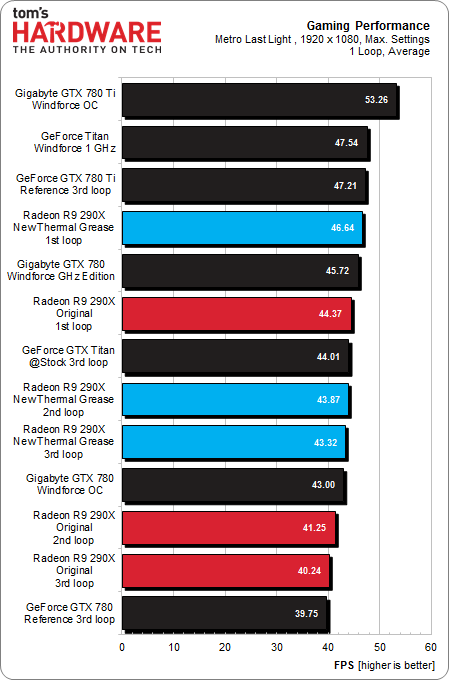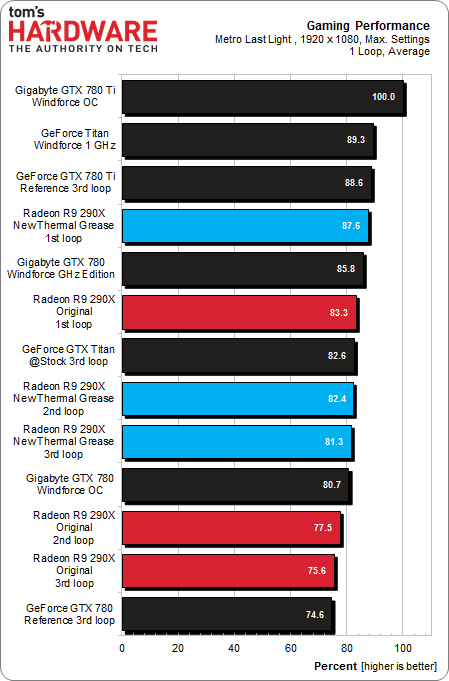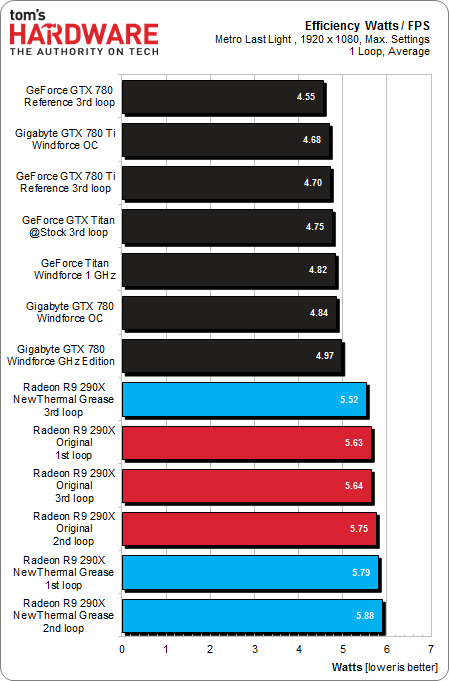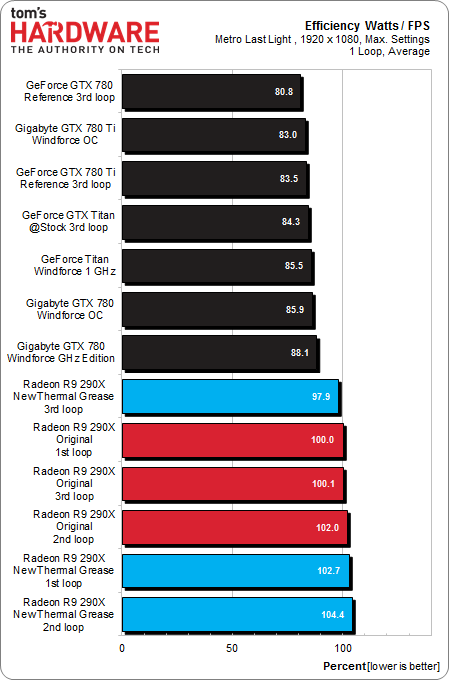Tuning Radeon R9 290X: Replace The Thermal Paste For More Efficiency
After receiving an enormous amount of feedback on our Radeon R9 290X review, we grabbed yet another retail board, which demonstrated the same performance issues under load as we saw in our earlier investigation. Looks like it's time to disassemble a card!
Performance And Efficiency
In order to extend the comparison, we added several of Nvidia's GeForce graphics cards with and without reference coolers to the charts, including the GeForce GTX 780, 780 Ti, and Titan. Replacing the original thermal compound on AMD’s Radeon R9 290X results in a remarkable performance gain.
During its first loop, the stock Radeon R9 290X is even with Nvidia's GeForce GTX Titan on its third loop. However, it pulls ahead of Gigabyte's factory-overclocked GeForce GTX 780 with its Windforce cooler once we apply our replacement thermal compound. It even comes close to the reference GeForce GTX 780 Ti...at least on its first loop.
Unfortunately, the R9 290X loses ground during the second loop. Its Hawaii GPU is pushed to its temperature limit and gaming performance decreases significantly. The third loop provides the most consistent results, as the card stabilizes on roughly the same average frame rate observed during the second run.
Translated into percentage terms using Nvidia's GeForce GTX 780 Ti as the 100% baseline, you get the following values:
Now think back to the power consumption measurements. The Radeon R9 290X drew less power during the second and third loop. Does this translate to a gain or loss of energy efficiency?
To our surprise the third loop using higher-quality thermal compound turns out to be the Radeon R9 290X's most efficient operational state. In plain English, that means a slightly lower frame rate is accompanied by considerably lower power consumption. This is contrary to what we've seen from the smaller Radeon R9 290, which is able to outperform Nvidia's reference GeForce GTX 780 Ti at an operating temperature of 83 °C once we replaced its original cooler with Arctic's Accelero Extreme III. If you haven't seen that story yet, check out Fixing The Radeon R9 290 With Arctic's Accelero Xtreme III.
The second loop turns out to be least-efficient. Shortly after the card's temperature limit is reached, Power Tune steps in and reins in consumption.
Get Tom's Hardware's best news and in-depth reviews, straight to your inbox.
After replacing its thermal compound, the Radeon R9 290X's energy efficiency is just 10 percent behind the three-percent-faster GeForce GTX 780 Ti Windforce GHz Edition during the third test loop and after its limiter kicks in. Thanks to Gigabyte’s excellent cooling solution, its 780 Ti does not exceed a GPU temperature of 70 °C.
Given proper cooling, AMD does pretty well. The Radeon R9 290X could even turn up ahead of Nvidia's GeForce GTX 780 Ti in a measure of frame rate-per-dollar. For now, though, Nvidia's board partners offering custom cooling and factory overclocking maintain a lead over AMD's flagship. That's the last word until AMD's own partners get enough supply of Hawaii GPUs to release modified versions of the 290X leveraging more effective cooling.
Current page: Performance And Efficiency
Prev Page Power Consumption: Before And After Next Page Answering Those Questions With Real Data
Igor Wallossek wrote a wide variety of hardware articles for Tom's Hardware, with a strong focus on technical analysis and in-depth reviews. His contributions have spanned a broad spectrum of PC components, including GPUs, CPUs, workstations, and PC builds. His insightful articles provide readers with detailed knowledge to make informed decisions in the ever-evolving tech landscape
-
Benthon Pretty disappointed to see the surface was so beat up, but still great to see what a little thermal paste upgrade can do.Reply -
Mottamort Great article again, Tom's has released some really informative articles the past few months, keep it up!Reply -
ginjaninja7 Well we wil have to see how the GPU performs with Gigabyte's own Cooling system. :-)Reply -
Crashman Reply
I like blower coolers when they work right, but I can guarantee that no company will produce a 290 with a top-end blower. These companies are just too lame to come up with anything like that. They'll go with triple-fan solutions to appease users who don't care about all the heat that rises up to their CPUs, or simply don't know any better. And Nvidia will remain the only supplier of cards with top-end blower coolers.11962019 said:Well we wil have to see how the GPU performs with Gigabyte's own Cooling system. :-)
-
s3anister "The biggest problem with this is that you void the manufacturer's warranty in the process. "Reply
Yeah, no thanks. The stock TIM should be the best solution already and the fact that it's not is crap either way. If you add in the fact that you need to replace the TIM to get decent results it's total bs. -
Zeh It's clear that AMD, maybe nVidia and their partners aswell, have a lot to learn from TomsH when it comes to details.Reply
The cost savings they would get by deliberately choosing not to do a finishing pass during their machining process, aswell as the badly applied and poor quality thermal grease would SURELY NOT make sense on a flagship aiming to be the best single gpu on the market.
@AMD: Details matter. Especially the low cost, effective ones.
@Crashman: Do you prefer blower type coolers? Correct me if I'm wrong, but dont they trade acoustic performance for getting rid of hot air? -
faster23rd Wow, beating even the 780 ti with that kind of margins and with just (well, it does void the warranty) a change of thermal paste! Goes to show what kind of beast Hawaii is, and it really is up to the board manufacturers now.Reply -
XyzyxRd The condition of the contact point for the GPU is completely unacceptable on a $500 plus card. Under normal handling this sort of damage should never occur. I've run both AMD and Nvidia cards and this sort of disclosure will make me think twice before seriously considering an AMD card for future builds.Reply -
rwinches Ok but how did the board perform with the new paste and not in quiet mode?Reply
Because even if it offended your sensitive ears would it have an effect on reaching the 94C limit?



